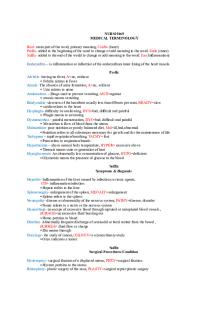Sonographic terminology PDF

| Title | Sonographic terminology |
|---|---|
| Course | Abdominal Ultrasound |
| Institution | Central Queensland University |
| Pages | 2 |
| File Size | 145.9 KB |
| File Type | |
| Total Downloads | 84 |
| Total Views | 212 |
Summary
Download Sonographic terminology PDF
Description
SONOGRAPHIC TERMINOLOGY
echogram / sonogram / sonogenic
Term used for an ultrasound scan (like “photogenic”).
echotexture
The echo pattern of a structure and may be smooth, coarse or mixed (varied).
echogenicity
The strength of the echoes in the image. May be mid level, high level or low level.
homogeneous
Uniform echogenicity or texture.
heterogeneous / inhomogeneous
Non-uniform echogenicity or texture.
anechoic / echolucent / sonolucent
Without internal echoes.
Sonodense
Does not transmit sound.
echogenic / hyperechoic
Comparative term for a structure that is more echogenic than another.
Hypoechoic / echopenic
Comparative term for a structure with fewer echoes than another.
isoechoic
Comparative term for the same echogenicity as surroundings.
cyst
A rounded / oval shaped fluid filled structure which is anechoic with smooth thin walls, good through transmission and often has edge shadow artefact.
cystic
Term often used for fluid filled structures; the structure is not necessarily a cyst.
complex
Mass with a variety of echoes within it; usually fluid and solid.
Fluid level
Interface between 2 fluids with different acoustic properties. Fluid levels may change with patient position.
regular
Refers to the smooth and regular margins of a structure.
irregular
Refers to the margins of a structure.
CG91 SONOGRAPHIC TERMINOLOGY LIST_2013
Page 1 of 2
SONOGRAPHIC TERMINOLOGY
Relativity of echogenicity When assessing the echogenicity of a structure the findings are compared to other structures and the normally expected findings of the structure being insonated. The main factors to keep in mind are:
Each tissue typically has a particular echogenicity. There is a relative scale of echogenicity amongst most organs in the abdomen.
Organ echogenicity is comparative where one organ is compared to another. Imaging controls are not adjusted when comparing organ echogenicity. The liver is the main organ used for comparison as it is the dominant organ in the abdomen. In diseased states, the echogenicity of an organ may be altered and be more hyperechoic or hypoechoic than usual. These observations can help to recognise and categorise the type of disease process involved. Sound transmission is increased posterior to a cystic structure (posterior enhancement) and usually decreased posterior to a solid mass (shadowing), dependant on the acoustic properties of the tissue.
How to describe a structure When describing an abnormal ultrasonic structure the following list should be included in the description whenever possible and as appropriate. This ensures clear identification and description of the structure.
Location Size Number Shape Echotexture Echogenicity Internal structure Walls of the structure Any effects on the surrounding structures (eg posterior enhancement, shadowing, compression, distortion)
CG91 SONOGRAPHIC TERMINOLOGY LIST_2013
Page 2 of 2...
Similar Free PDFs

Sonographic terminology
- 2 Pages

Immunology Terminology
- 2 Pages

Music Terminology
- 11 Pages

Medical Terminology
- 6 Pages

Medical Terminology
- 2 Pages

Github terminology
- 4 Pages

Medical Terminology
- 4 Pages

Cruise Terminology
- 2 Pages

Poetry terminology
- 2 Pages

Medical Terminology
- 50 Pages

Terminology 1
- 2 Pages

Experiment Terminology
- 1 Pages

Terminology FPA
- 11 Pages

Nutrition diagnostic terminology
- 1 Pages

Basic Microbiology Terminology
- 2 Pages

Med Terminology Chapter 4
- 2 Pages
Popular Institutions
- Tinajero National High School - Annex
- Politeknik Caltex Riau
- Yokohama City University
- SGT University
- University of Al-Qadisiyah
- Divine Word College of Vigan
- Techniek College Rotterdam
- Universidade de Santiago
- Universiti Teknologi MARA Cawangan Johor Kampus Pasir Gudang
- Poltekkes Kemenkes Yogyakarta
- Baguio City National High School
- Colegio san marcos
- preparatoria uno
- Centro de Bachillerato Tecnológico Industrial y de Servicios No. 107
- Dalian Maritime University
- Quang Trung Secondary School
- Colegio Tecnológico en Informática
- Corporación Regional de Educación Superior
- Grupo CEDVA
- Dar Al Uloom University
- Centro de Estudios Preuniversitarios de la Universidad Nacional de Ingeniería
- 上智大学
- Aakash International School, Nuna Majara
- San Felipe Neri Catholic School
- Kang Chiao International School - New Taipei City
- Misamis Occidental National High School
- Institución Educativa Escuela Normal Juan Ladrilleros
- Kolehiyo ng Pantukan
- Batanes State College
- Instituto Continental
- Sekolah Menengah Kejuruan Kesehatan Kaltara (Tarakan)
- Colegio de La Inmaculada Concepcion - Cebu